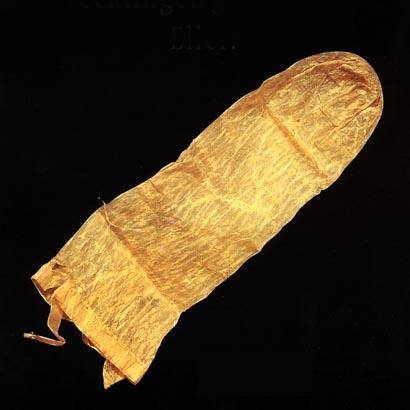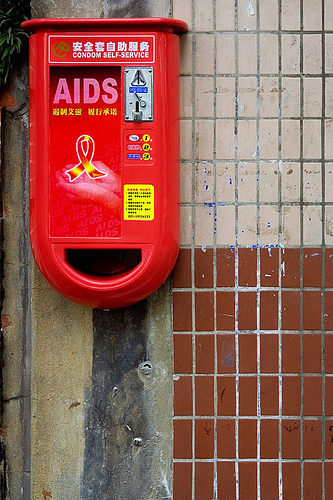-
The Youngs Rubber Company was the first company to launch a latex condom, the Trojan. The Durex company was founded in 1932.
-
In France, the condom was not approved until 1987. In the USA, condoms were only allowed in sex shops for a long time.
The history of the condom: A journey through time
Everyone knows them: condoms. But only few know the origins of the humble rubber. We take a look back at the beginnings of male contraceptives.
The history of contraception
Antiquity: Contraceptives in ancient societies
As early as 6,000 years before our era, some Egyptian sculptures showed a kind of sheath placed at a strategic point in the male anatomy, without us really knowing the significance of this genital protection until today. For it could indicate both a ritual and a genuine contraceptive or even a protection against venereal disease. In short, the exact origins of the male contraceptive are unclear.

Whether condoms - as we know them today - existed for men in ancient Greece and Rome is still a matter of debate, as there is no concrete evidence of this yet. But there are hints that the Greeks and Romans occasionally used a simple protection; a kind of sheath that encases the penis. As for the material, one legend associated with King Minos mentions the use of fish or goat bladders, while other sources speak of sheep or lamb intestines sewn together at one end and attached to a band tied around the penis at the other.
Renaissance: Syphilis as a driver of innovation
To find the first concrete and proven traces of a prototype condom, one must turn to the Renaissance in Italy; a time when France was trying to conquer the Kingdom of Naples and the Duchy of Milan. In the midst of these eleven successive wars with Italy, we find the first records of the syphilis epidemic - a highly contagious disease also known in France to this day as "la vérole". At the time, it was quickly renamed as the "french disease or "morbo gallico" by the Italians in general and by Gabriele Falloppio in particular.
The work "De Morbo Gallico" by the Italian anatomist Gabrielle Falloppio, published in 1564, is about the symptoms and causes of syphilis, but it also contains the first description of a utensil that Falloppio is said to have invented: a kind of linen sheath that does not cover the entire penis but only the glans, being held in place by a small cord tied under the base of the foreskin. The text suggests that, according to Fallopio's version, the condom was neither a prophylactic nor a contraceptive per ser, but a mode of care.

In the Age of Enlightenment: The Focus is on Sex
In the 18th century, the condom appeared in literary sources - there are countless of more or less direct references to a product that was still made by hand, but was now custom-made in the truest sense of the word. Like the materials, the size also varied to accommodate the anatomical peculiarities of one person or another on the one hand, and to satisfy the customers on the other. Because although they understood the double benefit of condoms - as disease prophylaxis and contraception - they were reluctant to wear them for two main reasons: they were not very flexible, uncomfortable to put on and difficult to keep in place; and they limited the sensation and were also considered unreliable - and rightly so. In addition to the natural porosity of some fabrics, there were small holes that naturally appeared when certain products were used several times, washed and left to dry before being carefully stored until the next use.
In addition to some agile and experienced users, in a civilisation that was steeped in the commandments of the church, there was also a form of ignominy: contraception was sin, sex for pleasure was debauchery. Most doctors adhered to this as well. In 1787, Daniel Turner, a famous English doctor, opposed the condom, which in his eyes fulfilled none of the roles ascribed to it: The condom was ineffective in terms of contraception and had, in his eyes, the enormous disadvantage of tempting its users to engage in more risky sexual contacts, in the insane belief that they were protected against syphilis or other sexually transmitted diseases.
The condom: from luxury good to mass product
For centuries, and regardless of the material used, the condom remained a luxury product due to the expensive manufacturing process. The path from the sheep's intestine to the finished application product was laborious and only a few men outside the aristocratic and bourgeois circles could afford this "luxury". Women, on the other hand, had little to no opportunity to acquire a male contraceptive. For women in the prostitution trade, the price of a condom was equal to several months' salary.
But the economic situation was soon to change. The condom gradually became an industrial product, because the US chemist Charles Goodyear had discovered a revolutionary process in 1839: vulcanisation, with which raw rubber could be converted into elastic and resistant rubber. The condom quickly rose to the top of the monumental list of resulting applications, as rubber is also washable and thus reusable. When a certain Macintosh, who until then had specialised in the manufacture of raincoats and balloons, had the right hunch and started the industrial production of rubber condoms in 1870, a real epochal change occurred in contraception and the fight against sexually transmitted diseases.

The return of morality
It should be noted that, of course, not everyone welcomed the proliferation of a product that was very quickly accused of having negative effects on the birth rate on the one hand and on public morals and customs on the other. Throughout the Western world, condoms have been subject to restrictions, and the US is the best example. While condoms could be bought literally anywhere there in 1870 - even by mail order - Congress passed the Comstock Act in 1873, a law that made it illegal to advertise and sell by mail order "any article of an immoral nature, or any drug, medicine or article for the prevention of pregnancy". In a country where consumers often live far from urban centres, this is a way of killing the condom without taking responsibility for it, as Washington left this to the states. 30 states of the union banned the manufacture and sale of condoms in the 1870s, which was a welcome change for black market traders selling condoms "under the table" - just as bootleggers used Prohibition to sell contraband alcohol.
Elsewhere, the same trend unfolded, sometimes creating curious paradoxes, as in Germany and Italy, where the sale of condoms was banned as a contraceptive but allowed for disease prevention. In England, too, retailers and manufacturers were adapting and making a habit of advertising condoms as prophylactics, at least seemingly forgetting the more recreational aspect of the condom. And in many households, the condom had its place in the medicine cabinet to help couples who did not want to have children. Between 1890 and 1900, a study conducted in New York showed that 45 % of women in the city used condoms to avoid unwanted pregnancy.
Something that the condom owes to the war
However, it was the two world wars that made the authorities rethink the condom question. At a time when the discovery of latex gave rise to a new generation of condoms1 that were thinner and more comfortable to wear, the health of soldiers became a major issue, as no officer wanted to see half his troops lying on their sides after a holiday. The condom was therefore included in the German soldiers' luggage along with other "pharmaceutical" products. The US troops did not benefit from the condom when they arrived on the Western Front in 1917. And by 1918, the US army found that 400,000 of its men had returned from Europe with an STI, usually gonorrhoea or syphilis.
"Every soldier is strictly obliged to use the freely supplied preservatives." Note on the use of condoms in a German soldier's brothel in Brest, France, 1940.
The lesson was learned: from the 1930s onwards, every soldier regularly received a pack of condoms, which soon became as commonplace as a pack of tobacco. Moreover, at the time, the condom found its home in everyday use: in the midst of the Great Depression, when many US households could no longer afford to feed several children, 1.5 million condoms were consumed daily in the US.
To revive the birth rate and compensate for the enormous human bloodshed of the First World War, France banned the free sale of condoms and all other contraceptives in the 1920s, but industrial development had already taken off. In the interwar period, all European armies continued to equip their soldiers with them, without hesitation, and benefiting from factory automation and the decline in the unit cost of condoms. The Second World War led to a further acceptance of a product that was now advertised by all military officers.
A condom for all cases
In the 1950s and 1960s, the impact of the discovery of penicillin limited the spread of the condom as a means of protection. Since it was possible to effectively treat certain venereal diseases - first and foremost syphilis - medical progress had in some ways led to laxity. The condom, which became more reliable over time (and thanks to quality control procedures introduced by US states), nevertheless continued to be widely used in the thirty years after the end of the Second World War and remained the most effective contraceptive until the invention of the contraceptive pill. Even as the pill gained acceptance, it remained the second most widely used contraceptive and contributed to the gradual phase-out of older methods, from the classic coitus interruptus to the Ogino-Knaus method.
In plain English, this means that many people made sure they always had a condom at hand, be it in their bedside drawer or in their wallet. Some countries even break records: Japan, still the world record holder since the 1960s, has the highest number of condoms used per capita annually - and for good reason: the pill was only approved there in 1999 and is still only used by 5-10 % of women today.
Nevertheless, the unease remains and morality still interferes: In many countries, the advertising of condoms is still banned2 or severely restricted, again, for moral reasons. Whether one says it or not, the condom remains associated with a form of "moral retreat" that the most conservative parts of Western societies find difficult to endure.

